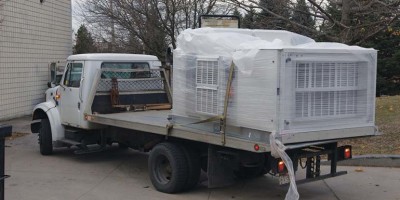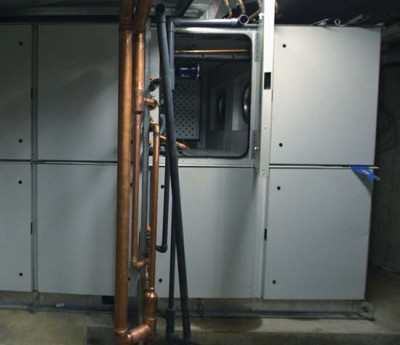Going modular

In addition to gutting existing dehumidifier shells that cannot be removed from mechanical rooms without the high cost of altering the building envelope, manufacturers have also developed modular units. These smaller systems fit through 813-mm (32-in.) doorways and can be installed in tandem. Two to four modular units can be individually wheeled through single- or double-pedestrian doors and then combined to equal the capacity of one large unit.
A case in point is the Cummer Park Community Centre in Toronto. The lifecycle of the 25-m pool’s dehumidifier was over; however, there was no way the manufacturer’s representative/contractor on the project was going to get a new dehumidifier, the same size as the existing system (4.8 x 2.4 x 2.4 m [16 x 8 x 8 ft]), through the mechanical room’s 1219-mm (48-in.) wide doorway. An original design called for two half-sized units with a remote exhaust fan and two separate heat recovery units. This would have made ductwork connections and controlling two separate units quite challenging.
Instead, the contractor installed two, 16-ton (2.3- x 1.5-m [7.5- x 5-ft]) modular units that could fit through 1117-mm (44-in.) access doors. The two units are stacked on top of each other and are designed for integration of heat recovery and exhaust fans, making for an easy installation and cost savings for the city. Typically, modular units stacked on top of each other equal a significantly smaller footprint than a conventional dehumidifier; however, for the Cummer Park project, energy-saving components that were previously remote from the original dehumidifier, such as exhaust air-energy recovery, were packaged inside the modular units, which accounted for a similar footprint.

Modular units are designed for this purpose and are easily and quickly piped and wired together once they have been wheeled into the mechanical room. Since they are separate units—each having its own compressor, coil, and supply air fan—they can operate together or independently in staged operation, which can add energy and redundancy benefits for the facility.
The staging ability modular units offer is particularly strategic for natatoriums with activities carrying varying capacities. A small swimming class comprising less than 10 bathers requires less dehumidifier capacity compared to dozens of people in an active public swim period or a six-hour-long swim meet with hundreds of participants and spectators. Natatoriums with one large system uses its full capacity compressor to handle any event, whereas two modular units could be staged down to operate just one smaller compressor during less occupied periods or even unoccupied nighttime settings.
Additionally, modular units offer redundancy. For example, a natatorium equipped with one large system would need to go without dehumidification—should the unit breakdown—until the repair is completed. Conversely, if one of two modular units breaks down at an aquatic facility, the remaining unit can still dehumidify the indoor environment to some degree.
Now anything is possible
Tight, inaccessible mechanical rooms have dealt today’s indoor pool facility manager a hand that might initially seem impossible to overcome when it is time to replace the dehumidification system. That said, a good look at the new techniques manufacturers have developed to override these setbacks deserve consideration versus the expensive approach of other construction-centric methods to accommodate the installation of a new dehumidifier into a small mechanical room.
 Ralph Kittler, P.Eng., is co-founder and vice-president of sales and marketing of Seresco USA in Decatur, Ga., a subsidiary of Seresco Technologies Inc., an Ottawa-based manufacturer of natatorium dehumidifiers and outdoor air ventilation only systems (OAVOS). He has 25 years of experience in the heating, ventilation, and air conditioning (HVAC) industry and a degree in mechanical engineering from Lakehead University in Thunder Bay, Ont. Kittler recently produced a free ‘Professional Development Hour’ (PDH) video available at www.serescodehumidifiers.com, which targets the continuing education requirements for engineers, but also serves as an invaluable primer of indoor pool design and operation basics for facility managers. He can be reached via e-mail at ralphkitter@serescodehumidifiers.com.
Ralph Kittler, P.Eng., is co-founder and vice-president of sales and marketing of Seresco USA in Decatur, Ga., a subsidiary of Seresco Technologies Inc., an Ottawa-based manufacturer of natatorium dehumidifiers and outdoor air ventilation only systems (OAVOS). He has 25 years of experience in the heating, ventilation, and air conditioning (HVAC) industry and a degree in mechanical engineering from Lakehead University in Thunder Bay, Ont. Kittler recently produced a free ‘Professional Development Hour’ (PDH) video available at www.serescodehumidifiers.com, which targets the continuing education requirements for engineers, but also serves as an invaluable primer of indoor pool design and operation basics for facility managers. He can be reached via e-mail at ralphkitter@serescodehumidifiers.com.







Indoor swimming pools rooms create their own environment and can be be a big problem when trying to control mold, mildew and dampness. That’s why you need an excellent ventilation and / or dehumidification system. This is something that home owners overlook the seriousness of when thinking of building an indoor pool.